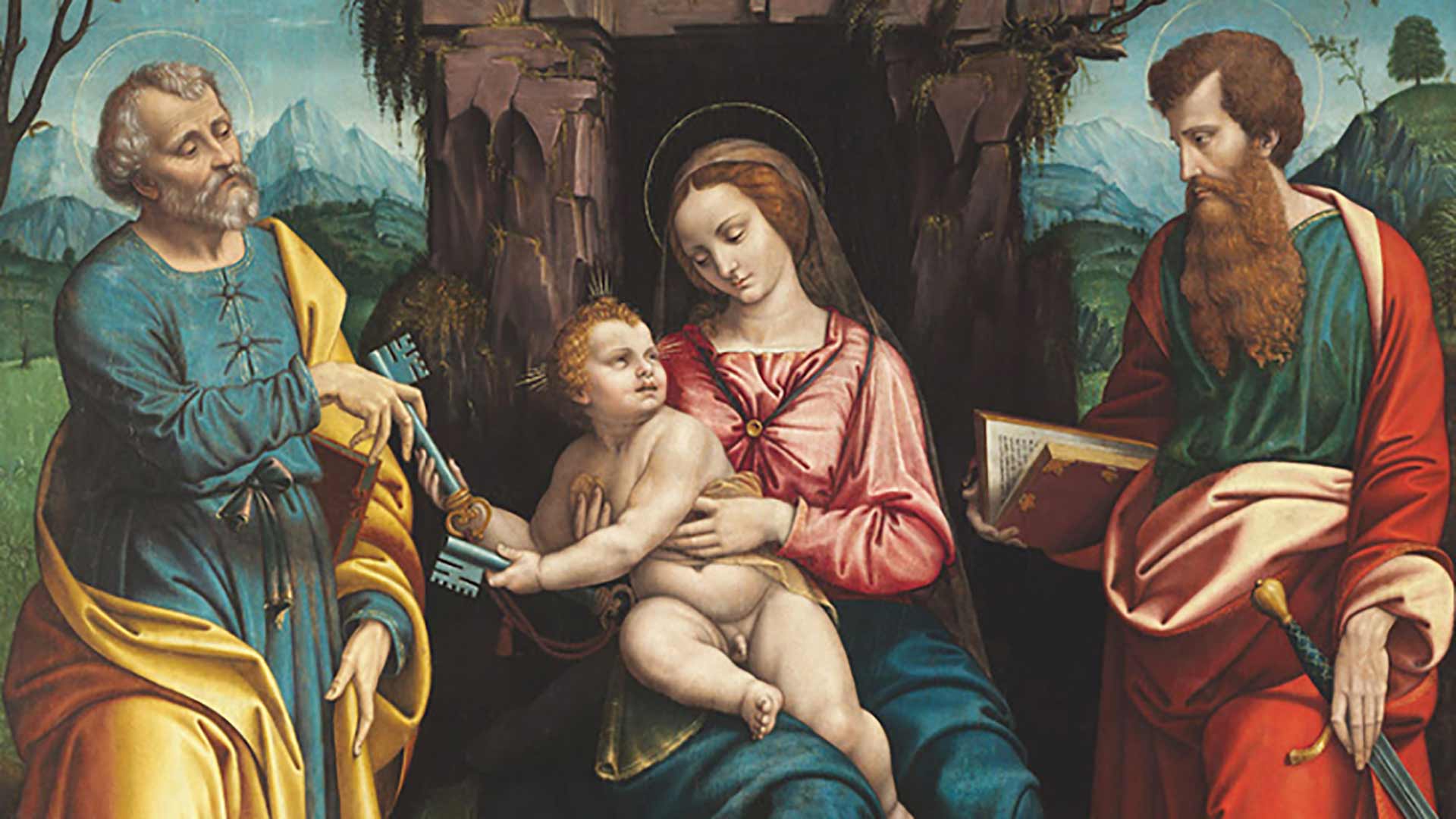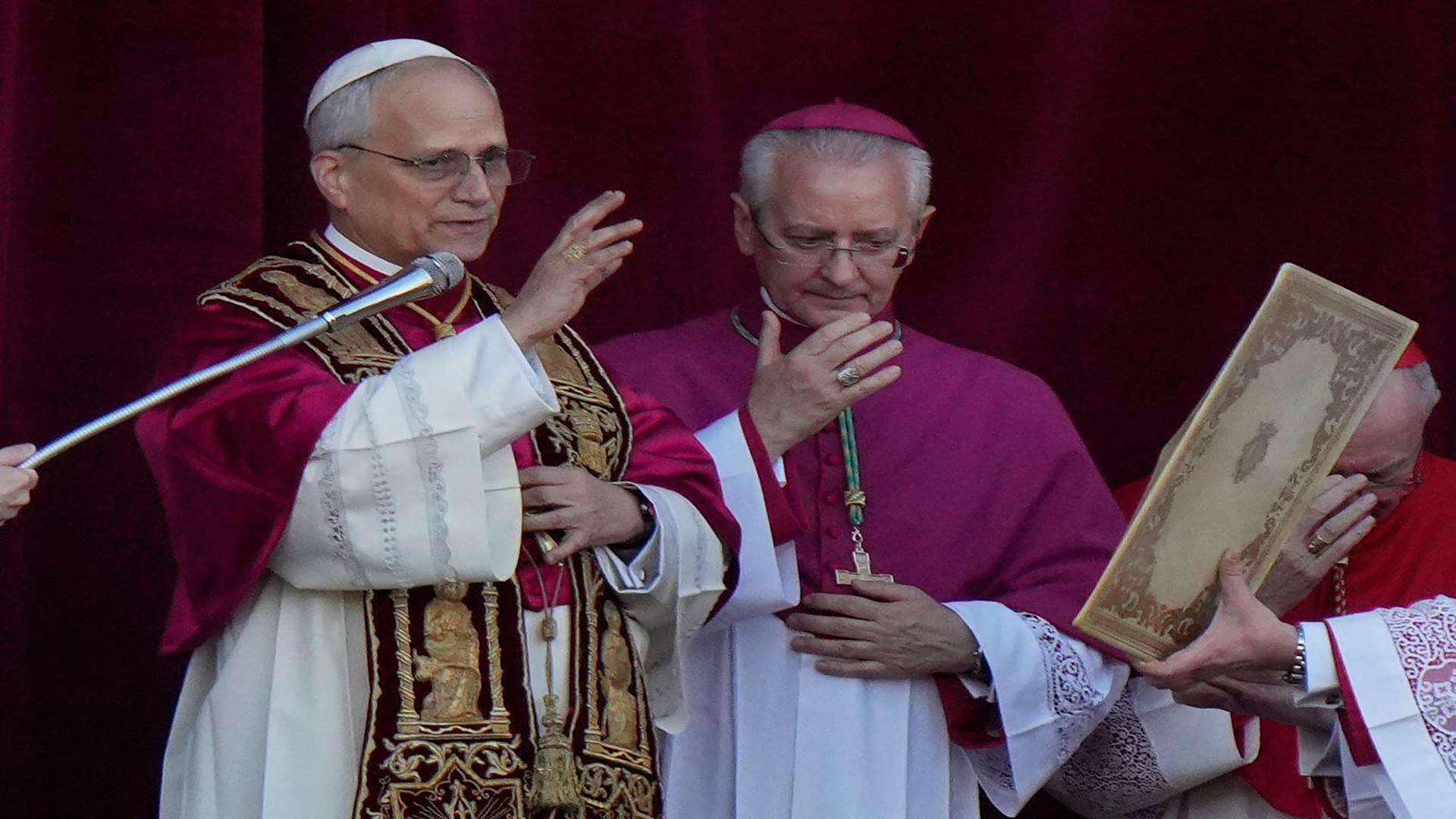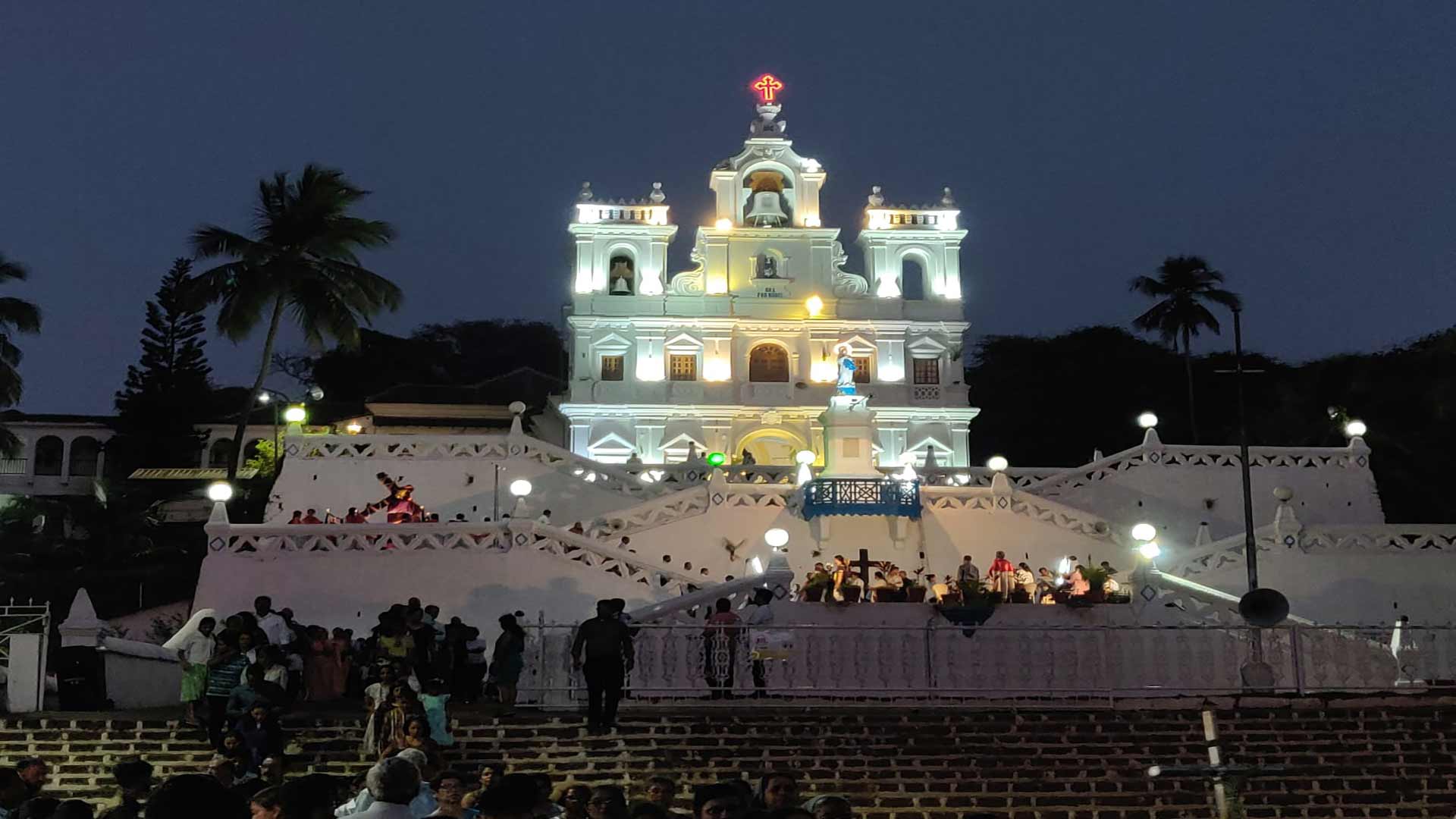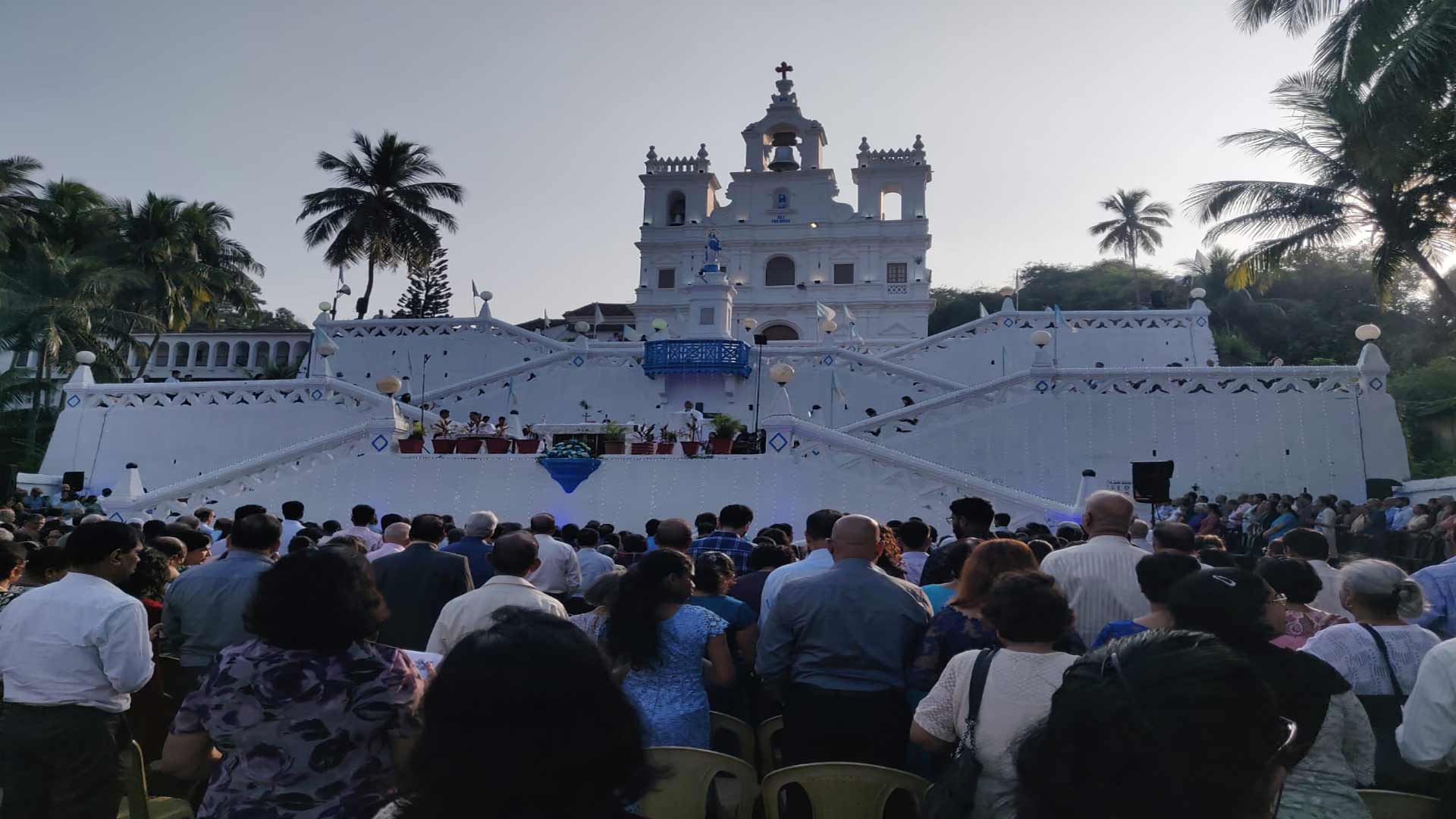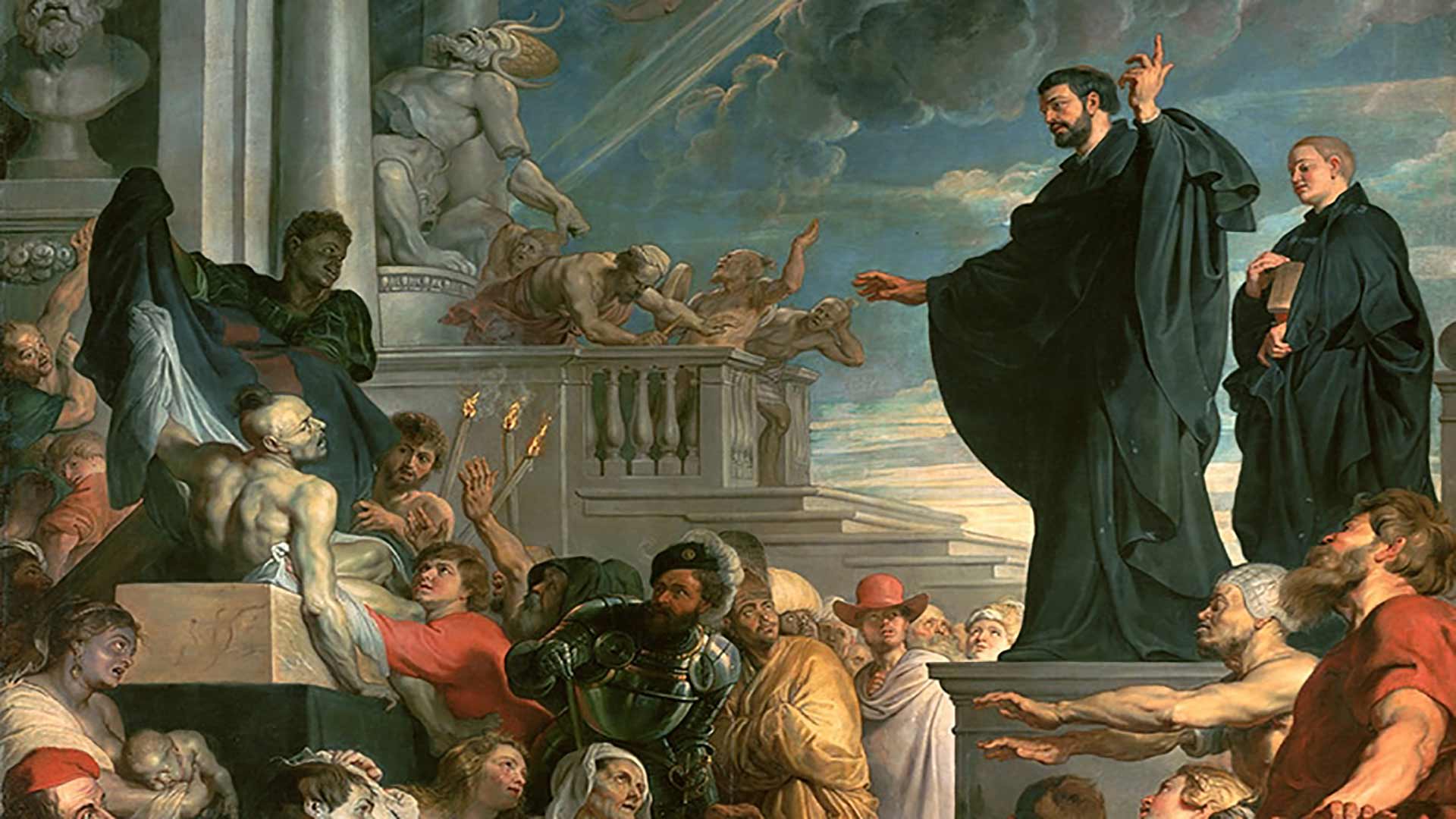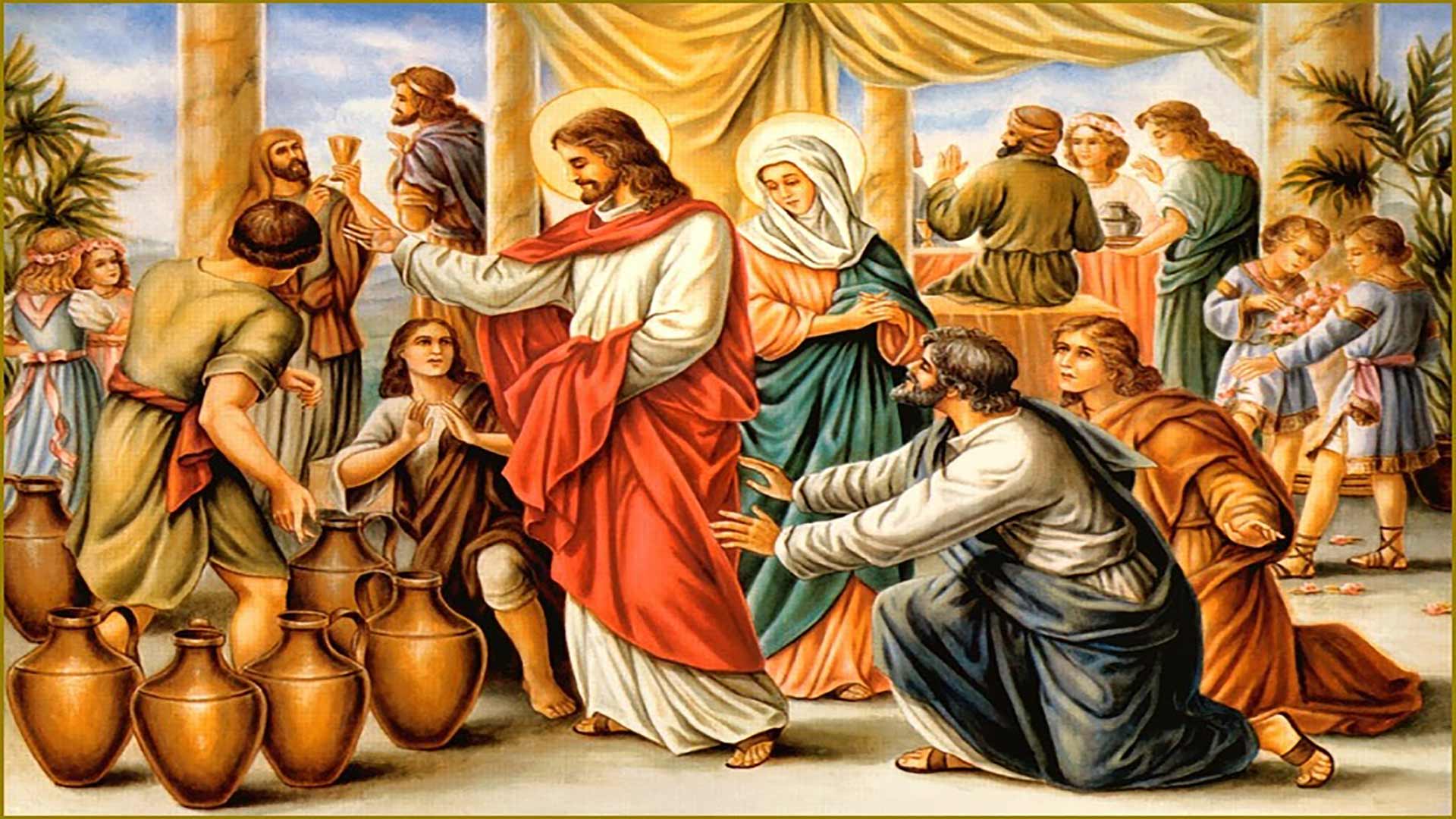Between Jerusalem and Rome
The Readings of the Fourteenth Sunday of the Year especially grab our attention. In the First, we see Isaiah’s colourful imagery involving Jerusalem (Is 66: 10-14); in the Second, we have St Paul’s passionate testimony (Gal 6: 14-18) based on his life experience in the Roman Empire; and in the Third, Jesus exhorts His disciples to travel to the ends of the world (Lk 10: 1-12, 17-20).
With the goings-on in Israel, however, can we legitimately ‘rejoice with Jerusalem, and be glad for her, all you who love her’? Must we love her at all? Regardless of the present conflict in the region (pushed by the modern State of Israel, which is not the biblical Israel), we ought to love Jerusalem as the cradle of Christianity and the city where Our Lord lived, died, and rose. Therefore, the Church favours a two-nation solution to the Israel-Palestine imbroglio and an internationally guaranteed special status for Jerusalem, with access to the holy places guaranteed.
For his part, the Jewish Prophet Isaiah is an integral part of our Christian heritage. His colourful images come alive even for us who have long looked to Rome for spiritual inspiration. Rome is the centre of the Catholic Church, the seat of the Papacy, and the location of Vatican City, an independent city-state, albeit surrounded by the city of Rome. The Church prays for the conversion of Israel, specifically for the Jewish people to acknowledge Jesus Christ as the Messiah. All this makes the reference to Jerusalem all the more significant.
Of course, with Jesus, it became clear that salvation is not the preserve of the Jewish people. No doubt, it was first proclaimed to them. Jesus spoke first to the Twelve (see Lk 9), and then to the Seventy-two. Knowing that the Jewish officialdom would not take forward the divine mission, Jesus empowered His disciples to do so.[1] They went before Him to several places and ‘returned with joy’. And then, not only did Peter go to Rome and Paul journey through the Roman Empire, but Thomas came as far as India and died there.
A fragment of today’s Gospel text rings in the ear of every Christian: ‘The harvest is plentiful, but the labourers are few.’ He set them out ‘as lambs amid wolves’, anticipating trials and tribulations in a hostile world. Yet, He bid them to ‘carry no purse, no bag, no sandals, and to salute none along the way.’ They were not to waste time in elaborate greetings, so typical of Oriental cultures, but to focus on announcing the Good News without delay.
Furthermore, the disciples were to eat, drink, and accept accommodation as provided to them, ‘for the labourer deserves his wages’; but they were not to have great expectations or make demands. God would sustain them. They had to reach out to the sick physically and spiritually, giving them the hope of eternal salvation. Divine Master gave His disciples practical tips, management skills infused with psychological and spiritual principles! It is no wonder that Vatican diplomacy possesses unique strengths and commands respect.
St Paul, the Apostle to the Gentiles, who witnessed crises in the communities he tended and overcame them, concludes his Letter to the Galatians as follows: ‘I do not wish to take pride in anything except in the Cross of Christ Jesus our Lord.’ So, it is not circumcision or uncircumcision but the Cross of Christ that matters for our salvation. This is a big eye-opener. We ought not to sacrifice the truth of the Gospel to materialistic values and goals, something that even those in authority sometimes do. We must hold steadfast to the divine message.
So, whether in Jerusalem, in Rome, or at home, we must strive to be true disciples of Christ, the salt of the earth and light of the world.
[1] How many did Jesus commission? Some codices say 70, others 72; both figures are correct, as they represent the pagan communities (70 in the Hebrew text, 72 in the Greek) mentioned in Genesis 10. St Luke is the only Evangelist who mentions this number, suggesting that Jesus would not limit Himself to the twelve tribes of Israel (denoted by the Apostles) but would reach out to all communities and nations.
Models of faith and courage
Today, the Church celebrates the Solemnity of Saints Peter and Paul. The Readings for the Vigil Mass[1] and the Day Mass are different, thus helping us to explore various facets of the feast and enjoy a richer liturgical experience. The Vigil Mass provides a broad overview, while the Day Mass offers specific insights into the lives and teachings of the two foundational figures of the early Church.
The Day Mass delves into the lives and ministries of the twin saints. In the First Reading (Acts 12:1-11), we see Herod’s persecution of the fledgling church. This was Herod Agrippa I, who ruled as king over Judea. He was the grandson of Herod the Great, who was on the throne when Jesus was born, and a nephew of the tetrarch of Galilee and Perea, Herod Antipas, who beheaded St John the Baptist.
Here, Herod is seen persecuting the early Christians, executing Zebedee’s son James the Great, and imprisoning Peter. But, miracle of miracles, the angel of the Lord visited Peter in jail and walked him out. The city’s iron gate opened to them of its own accord, and with Peter now in a safe zone, the angel left him without ado. All along, Peter thought he was seeing a vision, until he exclaimed: ‘Now I am sure that the Lord sent his angel and rescued me from the hand of Herod and from all that the Jewish people were expecting.’
The day’s Reading ends here, but the story continues with Peter meeting his fellow men huddled in prayer at the house of St Mark the Evangelist. He described to them how the Lord had brought him out. The angel’s intervention had been a direct response to the church’s fervent prayers for Peter's release. He requested them to inform James, a leader in the Jerusalem church. Then Peter departed and went to another place. And when day came, there was no small stir among the soldiers over what had become of Peter. A frustrated Herod ordered that the soldiers be put to death and died shortly thereafter, struck by an angel for accepting praise as a god.
While all this is believed to have happened in the year 44 AD, a decade or so after Our Lord’s Ascension, the Gospel text (Mt 16:13-19 covers a much earlier, ground-breaking episode in Peter’s life: his profession of faith. When Jesus posed the question, ‘Who do men say that the Son of man is?’, to Peter, He was unmistakably ‘Christ, the Son of the living God.’ Recognising that his answer came by inspiration from God the Father, Jesus answered: ‘And I tell you, you are Peter, and on this rock, I will build my church, and the powers of death shall not prevail against it. I will give you the keys of Heaven, and whatever you loose on earth shall be loosed in Heaven.’
Words of great import. They conferred primacy upon the son of Jonas, and set on him His Church, a name mentioned for the first time. Simon, the weak mortal of flesh and blood, was now destined to brave all assaults of Hell. Jesus assured him of the same stability that He gave to His Church, transmitting the privileges of Peter to his successors seated in the Chair of Infallibility and holding in their hands the Keys of supreme authority. They would give laws and guide kings and peoples, pastors and their flocks in the path of salvation; they would open and shut the gates of the celestial Kingdom.[2]
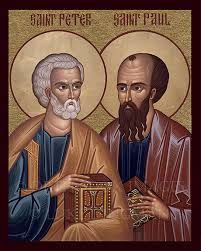
But these splendours were not free of troubles. Peter, the first Pope, endured persecution for the sake of the Church. Similarly, St Paul had his share of struggle and pain. But both persevered to the end. Hence, St Paul’s exhorted his people to preach the Word of God in and out of season, foreseeing that ‘the time is coming when people will not endure sound teaching, but having itching ears they will accumulate for themselves teachers to suit their likings, and will turn away from listening to the truth and wander into myths’ (2 Tim 4: 3-4).
How true, especially in our days, when ‘sound teaching’ is sometimes scorned for its directness. So, we go about our petty lives feeling just listless and complacent, if not revolted. But then, to keep up with the Joneses, we might find ourselves a cosy nook and turn to teachers who will whisper sweet nothings and never ruffle feathers. And as if these false teachers weren’t bad enough, we might even ‘wander into myths.’ These are now part of New Age movements that the Church cautions us against.
The Apostle to the Gentiles in the Second Reading (2 Tim 4: 6-8, 17-18), after speaking of his impending martyrdom, famously says: ‘I have fought the good fight, I have finished the race, I have kept the faith.’ He can legitimately hope that the Lord will award the crown of righteousness to him and to all who have waited for His appearing.
All of which brings into sharp focus a psalm for deliverance from trouble (34:2-9), which the afflicted will hear and be glad. It invites us to trust in the Lord at all times, to look to Him and be radiant, to taste and see that He is good! It comforts the afflicted to know that ‘the angel of the Lord encamps around those who fear Him, and delivers them.’ Hence, happy is the man who takes refuge in the Lord. Like St Peter and St Paul, we too must strive to be models of such faith and courage.
Banner: The Virgin and Child with Saints Peter and Paul, by Girolamo Figino
[1] Acts 3:1-10 (Peter and John healing a crippled beggar); Psalm 19:2-3, 4-5 (Their message goes out through all the earth); Galatians 1:11-20 (Paul's conversion and preaching); John 21:17 (Jesus asks Peter if he loves him); John 21:15-19 (Jesus reinstates Peter).
[2] Cf. l’Abbé C. Fouard, Jesus Christ the Son of God (Goa: Don Bosco, 1960), p. 258.
Celebrating Peter and Paul
Have you ever wondered why the Church celebrates St. Peter and St. Paul on the same day, 29 June? The tradition can be traced back to at least the third century. It is commonly believed that the two apostles were martyred on the same day, albeit three years apart, in circa 64 AD and 67 AD, respectively, under the infamous Emperor Nero. Another theory is that the day marks the anniversary of the translation of their relics. These are two of the most important explanations for the joint celebration, possibly instituted in the year 258.
Before the Christian era, 29 June marked the pagan festival of Romulus and Remus, legendary twins who founded Rome. Romulus was the city’s first king, but its founding date was not 29 June, but 21 April 753 BC. And, whereas the blood brothers founded the City of Seven Hills, brothers-in-the-faith St. Peter and St. Paul founded Christian Rome and are the patron saints of the Eternal City. So, regardless of the backstory, it can well be said that the Church Christianised the date in question.

Origins
St Peter is the founder of the See of Rome, and like him, St Paul too preached the Christian faith in the city. It is there that both were executed and buried. Peter was crucified, upside-down at his request, because he claimed to be unworthy to die on the Cross like his Lord. He was buried on Vatican Hill, and centuries later, St. Peter’s Basilica rose over his tomb.
Paul, on the other hand, was prescribed death by decapitation, given that he was a Roman citizen; crucifixion was a punishment reserved for non-citizens and slaves. His remains are housed in the Basilica of St. Paul Outside the Walls.
However, the two apostles are not linked in death alone. There are several other similarities and dissimilarities in the lives of these two seminal figures of the early Church.
Peter, originally Simon, was a fisherman of Galilee. He was the first of the apostles to recognise that Jesus was ‘the Messiah, the Son of the living God’ (Mt 16: 16). Jesus named him Cephas (Petrus in Latin), which means ‘Rock’ in Aramaic, for he was to become the rock upon which Christ would build His Church. Although he had pledged his fidelity until death, he had a momentary loss of faith – for example, when walking on water with Christ – and on the night of Christ’s Passion, he thrice denied Him.
Paul, originally known as Saul, was born in Tarsus, a city in south-central Turkey, near the Mediterranean coast. He was a well-educated Jew and Pharisee. Whereas Peter had a personal relationship with Jesus, Paul never met Christ face to face, but scorned His teachings and persecuted Christians. When on a hounding mission to Damascus, his dramatic encounter with Christ changed it all for him.

Turnaround
‘Every way of a man is right in his own eyes, but the Lord weighs the heart’ (Prov. 21:2).
Despite Peter’s many shortcomings, God chose him to shepherd His flock. The Acts of the Apostles notes that, in his capacity as the first bishop of Rome, he endured persecution and ensured that Christians kept the faith. St Peter is credited with writing two epistles: 1 Peter and 2 Peter. However, some scholars suggest that they may have been written by proxy.
Saul’s turnaround was even more spectacular. He continued on the road to Damascus with a contrite heart, received baptism, and got back his sight. Saul then became Paul. Breaking thus with his Hebrew identity, he exclusively used his Roman name, more familiar to Gentiles of the Mediterranean world, to reach a wider audience with the Christian message.[1]
St Paul spent the rest of his life in apostolic labours unequalled in Church history. While 13 letters included in the New Testament are traditionally attributed to him, many scholars believe that only seven are authentically Pauline: Romans, 1 and 2 Corinthians, Galatians, Philippians, 1 and 2 Thessalonians, and Philemon. The authorship of other letters, such as Ephesians, Colossians, 1 and 2 Timothy, and Titus, is debated.
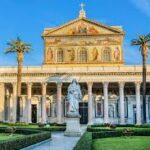
In our times
Peter and Paul are twin pillars of the Church. Their activity as the first Pope and as the Apostle to the Gentiles throughout the Roman Empire, respectively, quickly established Rome as the headquarters of the Church. The later recognition of papal primacy and the eventual establishment of the Vatican City within the city solidified its position as the Church’s central location.
The close association of Peter and Paul is clear. It is seen in theology and in art. There are also many churches dedicated to the pair. That is because, although distinct in origin and temperament, their ministries and teachings are complementary. This is all the more reason to celebrate them together. A partial indulgence is granted to the faithful who fervently recite the prayer in honour of the apostles on the Solemnity,[2] and a plenary indulgence to those who devoutly use a sacramental blessed by a bishop, provided they make a valid profession of faith during its use.[3]
Way back in the year 395, St Augustine of Hippo said of St Peter and St Paul: ‘Both apostles share the same feast day, for these two were one; and even though they suffered on different days, they were as one. Peter went first, and Paul followed. And so, we celebrate this day made holy for us by the apostles’ blood. Let us embrace what they believed, their life, their labours, their sufferings, their preaching, and their confession of faith.’
Notes
[1] In the first century, it was common for individuals to have dual names, one Hebrew and the other Roman, which they used interchangeably.
[2] “Partialis indulgentia conceditur christifideli qui orationem Sancti Apostoli Petre et Paule devote recitaverit. 'Sancti Apostoli Petre et Paule, intercedite pro nobis. Protege, Domine, populum tuum; et Apostolorum tuorum Petri et Pauli patrocinio confidentem, perpetua defensione conserva. Per Christum Dominum nostrum. Amen.” (in Enchiridion Indulgentarium, Concessiones, n°. 20, Libreria Editrice Vaticana, 4th edition, 2004, p. 67).
[3] "Christifidelis qui pietatis obiecto (crucifixo, cruce, corona, scapulari, numismate), a quovis sacerdote rite benedicto, pia utitur mente, consequitur indulgentiam partialem. Si autem pietatis obiectum a Summo Pontifice aut a quolibet Episcopo fuerit benedictum, christifidelis, eodem obiecto pia utens mente, assequi potest etiam indulgentiam plenariam die festo SS. Apostolorum Petri et Pauli, addita tamen, qualibet legitima formula, fidei professione." (in Enchiridion Indulgentarium, Normae, n°. 17, Libreria Editrice Vaticana, 4th edition, 1999).
References
https://www.catholicnewsagency.com/saint/sts-peter-and-paul-501
Catechism of the Catholic Church
Encyclopaedia Britannica
Freemantle, Anne (Ed.). The Papal Encyclicals in their Historical Context. New York: New American Library, 1956.
A Pope of Great Promise
The outcome of a papal conclave is always a surprise. Not only is the august assembly held cum clave, meaning under lock and key, the huge number of cardinal electors – who double as candidates – makes it impossible to guess who will emerge as the pontiff. Even though well before a conclave begins, different agencies float names of the papabile, these have only indicative value. The cardinal electors make their final decision on the spur of the moment, by the inspiration of the Holy Spirit. That’s how unpredictable a papal conclave can be.
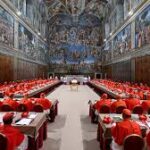
The secular world, however, looks at it as a numbers game or a power struggle. No doubt, historically, Europe has had the largest number of Popes (235/266), with Italians outnumbering them all (217). Yet it cannot be said that the papal office is racially defined. For instance, in the early centuries even the so-called Dark Continent produced Popes, whereas the white New World got its first one as late as the twenty-first century.
Furthermore, while 15 countries have produced Popes till date, including tiny Albania way back in the eighteenth century, longtime superpower USA had to wait until the twenty-first to have their very own top man at the Vatican. He possibly comes as a divine reward for the resurgence of faith and devotion (particularly with the National Eucharistic Revival) in his native country; but he has not trumpeted his national affiliations.
Finally, there will always be countries not making the grade, but surely no country or race will be deliberately excluded. So, no matter which part of the world the Pontiff comes from, he never fails to surprise.
First Impressions
The rise of Cardinal Robert Francis Prevost as an American is as good a surprise as it would have been if he were an Indian or an Australian. So long as he steers the Barque of Peter with faith and divine authority – that is all that matters.

That is why, even before I got to see the man in the Loggia delle Benedizioni, I felt the blessing of the name he had assumed: Leo XIV. Much as we may say ‘What’s in a name?’, a name is not without historical and cultural significance. It is selected after much reflection and with a purpose. Presently, it symbolises strength, courage, power and the determination to begin a course correction. It represents the divine kingship and majesty of Christ. It stands for the teaching authority of Jesus, who is the ‘Lion of the Tribe of Judah’ (Rev 5:5).
After a quick minute of great anticipation, the French window finally opened. I saw the man in traditional vestments. What most impressed me was his calm and gentle demeanour, humility and unpretentiousness. He came across as a simple and sincere prelate. He seemed authentic and accessible, straightforward and down-to-earth, with the ability to call a spade a spade. While he looked at the cheering crowds with tenderness, he was far from being over the moon with delight.
An unmistakable change in that iconic balcony! I said to myself, let bygones be bygones; the past is behind us – the present and the future are all that matter. The Loggia of Blessings was to me a window on the future. I began to imagine Leo XIV restoring all things in Christ. Just then, I heard the Vicar of Christ's deeply evocative greeting – Peace be with all of you! – ‘the first greeting of the Risen Christ, the Good Shepherd who gave His life for God's flock.’
Like a tender father, the Pontiff wished ‘this greeting of peace to enter your hearts, to reach your families, and all people, wherever they are, all of the people, all over the earth.’ He followed it up with reassuring words: ‘God loves us, God loves you all, and evil will not prevail! We are all in the hands of God.’ Calling disciples of Christ to join hands and move forward, he focussed on the Divine Master alone, saying: ‘Christ precedes us. The world needs His light. Humanity needs Him as the bridge to allows it to be reached by God and by His love.’
And then, lo and behold, there came words and phrases that had almost fallen into disuse: his was a call to be ‘faithful to Jesus Christ, without fear, to proclaim the Gospel, to be missionaries.’ Pledging his service as a true son of Saint Augustine, he turned the people’s gaze to ‘that homeland that God has prepared for us.’ A man of deep faith and experience indeed.
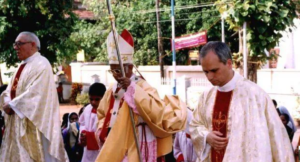

The Holy Father had a special greeting to the Church of Rome and to his diocese of Chiclayo, in Peru, ‘where a faithful people accompanied their bishop, shared their faith and gave so, so much to continue being a Church that is faithful to Jesus Christ.’ Words of gratitude, of encouragement, of zealous devotion are what we heard from the Loggia that blessed night.
But that is not all. His Holiness reminded the gathering that it was ‘the day of the Supplication to Our Lady of Pompeii. Our Mother Mary always wants to walk with us, to be close, to help us with her intercession and her love,’ and befittingly ended his first Urbi et Orbi blessing with a Hail Mary. I felt immensely comforted.
Tasks Ahead
The Lord our God has favoured us with Pope Leo XIV, thanks to the prayers of many zealous souls. For over a decade now, the likes of German Cardinal Gerard Müller, Guinean Cardinal Robert Sarah, US Cardinal Raymond Burke, German Bishop Athanasius Schneider; theologians, lay individuals and groups had been sounding the alarm bell about the waves of the world mercilessly buffeting the Barque of Peter. Providentially, the new Captain will steer the drifting ship back on course.
To my mind, the tasks ahead are many. Meanwhile, to maintain our integrity as Catholics, we must turn the spotlight on three fundamental issues. First, we must stress the importance and non-negotiable nature of the Sacred Tradition and the Holy Magisterium of the Church. As Cardinal Müller recently said, ‘the question is not between conservatives and liberals but between orthodoxy and heresy.’
Secondly, we must address the wrong notion that even some of us Catholics have of the Church’s mission. It is our duty to make Christ known, present, and active in the world. We must lead people toward a deeper relationship with Him and with one another. The Church is not a ‘humanitarian organisation doing social work’ but a spiritual lighthouse that affords a view of eternal life.
Thirdly, how can we recover from the identity crisis that ails us? It is fuelled by gas lighters, some of whom have infiltrated the Church. It is the proverbial smoke of Satan clouding our minds and making us look for validation from the secular world. The antidote is to appreciate, love and be grateful for the treasures of our Faith and our Church.

Let us entrust these issues and many others too long to list here to the leadership and wisdom of Pope Leo XIV and be continually surprised and amazed by God's work in our midst. No matter how hard it is to figure it out, he occupies the Chair of Peter by the express will of God, Who has said: ‘So is My word that goes out from My mouth: It will not return to Me empty, but will accomplish what I desire and achieve the purpose for which I sent it.’ (Is 55: 11).
Long live Pope Leo XIV!
Banner: https://www.thetablet.co.uk/news/first-urbi-et-orbi-blessing-of-the-holy-father-leo-xiv/
Prevost at the Vatican (2023) https://www.france24.com/en/europe/20250508-pope-leo-xiv-profile-robert-prevost-from-peru-missionary-to-first-american-pontiff
Holy Passion Processions in Panjim
At the Church of the Immaculate Conception – the Igreja Matriz or main parish church of Panjim – the sixth Sunday of Lent begins on a festive note. It is Palm Sunday, which commemorates the triumphant entry of Jesus in Jerusalem.
However, after the morning Masses, there is a visible change in the mood, especially with the unveiling of the tableau in the chancel: a larger-than life-size statue of Christ carrying the Cross. Hence, the day's alternative designation: Passion Sunday.

The evening of Passion Sunday features a solemn procession that begins from and ends at the iconic church. It is the highpoint of the Santos Passos (‘Holy Steps’) held on the first five Sundays of Lent, highlighting some of the most intense moments of Christ’s Passion leading to Calvary: the Agony in the Garden of Gethsemane; the Arrest of Jesus; the Flagellation at the Pillar; the Crowning with Thorns; the condemnation by Pontius Pilate (See my blogpost https://www.oscardenoronha.com/2019/03/17/santos-passos-in-panjim/ ). Other churches in Goa do not necessarily have the same set-ups (See https://www.oscardenoronha.com/2021/03/21/lenten-traditions-in-goa/ ).
Passion Sunday signals the beginning of the Holy Week. The predominant colour is purple; the altars are bare and there is not a flower arrangement to be seen. After the evening Mass, a procession called Cruz às costas – the same tableau of Jesus carrying the Cross – wends its way through some of the main thoroughfares of the capital city: the Church square, a section of 18 June, Pissurlencar, past Azad Maidan.


Confrades (Church confraternity members) wearing opa e murça (a red and white cape) carry the statue concertedly, giving the impression that it is floating on its own power. In the past, a brass band would follow; but nowadays, a choir sings from an intermediate landing of the church's zigzag stairway. The singing and prayers are heard throughout the route via funnel loudspeakers. The procession is animated by the recitation of five Sorrowful Mysteries of the Rosary until the end of the procession.
The circuit is marked by over ten descansos (halts), at which points the faithful flock to kiss the statue. A major halt happens at the Capela da Conceição (Chapel of the Immaculate Conception). Built in 1823, it was once a private chapel attached to the mansion of Dom Lourenço de Noronha, scion of a Portuguese noble family, and was later bequeathed to the Confrarias of Panjim church and has been under repairs since 2019.
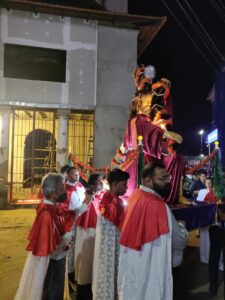


The cavalcade then proceeds via M. G. Road and Dr D. R. de Sousa, past the Garcia de Orta Garden, and up to the church square. Here, at the foot of the stairway, Jesus is met by His Blessed Mother. Sorrowing over her Son so unjustly accused and made to carry the Cross to His death, she accompanies him on his last last legs, as she did two thousand years ago to Golgotha.
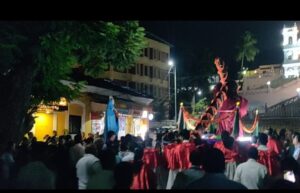
Soon thereafter, the two statues halt on the intermediate landing in front of a large cross carved out of the wall. A level higher, from a pulpit-like balcony jutting out of the said wall, a little girl unrolls the Veil of Veronica while she sings the traditional narrative. This is about the meeting of the legendary woman (feast day, 12 July) with Jesus. As recorded in the fourth station of the Via Crucis (Way of the Cross), Veronica, moved by the sight of Jesus carrying the Cross, wiped his brow with her handkerchief only to find a lasting imprint of his holy face on the cloth.
Thus ends Passion Sunday and preparations begin for the Holy Triduum beginning on the evening of Maundy Thursday. This day, which comprises a Mass with the reenactment of the historic Washing of the Feet by Jesus, marks the institution of the Eucharist and the Priesthood and the proclamation of the Commandment of Love. There is no public procession.
Five days later, on Good Friday, the processional arrangement is the same as on Passion Sunday, except for a few obvious differences.
The poignant Crucifixion tableau opens in the chancel at 3 o’clock in the afternoon. It is interesting how by then the sky is usually cloudy and the mood sombre. The liturgy of the Word and the Eucharist continue until at about half past five. Then, a procession of a larger-than-life-size statue of Senhor Morto (The Departed Lord) placed on an andor (black canopied wooden platform) starts off, with the statue of Our Lady in trail.
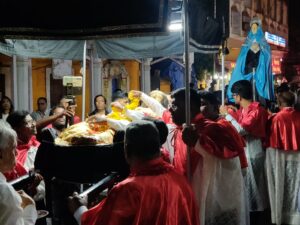
There are some other differences too. Today, the faithful are in funereal attire, which once upon a time was de rigueur. And instead of the sanctus bell, we hear the matraca or wooden rattle at every halt in the procession.
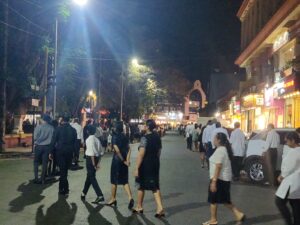
A major difference between the Passion Sunday and the Good Friday procession lies at their very end. This time round, in a coda to the baroque event, is the Sermão da Soledade de Maria (Sermon on the Solitude of Mary) delivered by a priest from the same pulpit-like balcony. The preacher extols the virtues of Mary and highlights her present solitude. Formerly, rhetoric played a crucial role on such occasions, helping to fully engage the congregation. Nowadays, the limited number of faithful who stay on to listen are easily distracted, not least by vehicle noises that detract from the solemn ambience.
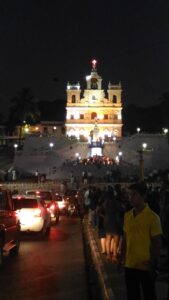
In this context, one striking similarity between the processions is that both are watched in awe by people of other religions. On both occasions, residences put up decorative lights, candles or oil lamps in homage to Our Lord. Some non-Christian establishments remain open, it being a weekday, do the same. People from other religions watch in awe, including policemen (one of whom I saw standing at attention and saluting the Departed Lord). Particularly interesting is the case of the Caculos and the Neurencars, two Hindu families on Pissurlencar Street; they traditionally offer garlands of xenvtim or abolim.
Depending on the number of attendees, the pious, kilometre-long march and related ceremonies on both days take between 75 and 90 minutes. The statues return to the church for concluding rites and veneration. By 8 o’clock, they call it a night!
Behold two processional events in Panjim that have left a lasting imprint on my mind. So was it when my life began; so is it now I am a man. So be it when I grow old – for this ancient tradition is without a doubt one of the most moving spectacles in the religious and cultural calendar of my city, Panjim.
Requests:
1- In the comments section below, do share snippets of similar traditions in your village or city, and document them whenever possible.
2 - Do watch my video titled "Passion Sunday Procession in Panjim", on http://www.youtube.com/@oscardenoronha
From Carnaval to Carnival
| To the Anglo-Saxons, ‘Carnival’ is a travelling fair or circus; to the Latins, or say, the Portuguese, Carnaval is a period of enjoyment or euphoria before Lent. Despite this Christian reference, Carnaval is far from being a religious festival. It is a cultural remnant from pre-Christian times, when the orgiastic Saturnalia was celebrated with tableaux in Rome and Athens.
The festival came to Goa via the Portuguese. At first they used the word Entrudo, of which Intruz is now a Konkani corruption. But given that Entrudo means ‘introduction’ one wonders how epicurean delights can ever be a good introduction to the austerity of Lent! For that matter, the word Gordo, as in Sábado Gordo (Fat Saturday) probably referred to people’s overeating and drinking. As a child, the expression brought to mind those silly, larger-than-life characters that walked the streets on the days of Carnaval. Of course, nowadays, it is the fat profits that the season brings in that better justify the use of the word! In town and country Although in Goa Carnaval and Intruz are sometimes used synonymously, locals know the difference: the former is city-based, cosmopolitan, sophisticated, while the latter happens in the countryside and has a plebeian feel. Anyway, revelry begins on Saturday afternoon and ends on the eve of Ash Wednesday. The festive atmosphere is more pronounced in the Old Conquests, where the Christian presence is larger; and the celebrations in the towns are noisier than in the villages. I remember my grandmother’s take on her childhood Carnaval in Pangim way back in the 1910s. Although it was marked by a lot of tomfoolery, ‘that fun was free of malice,’ she said. No doubt, there was a method to the madness of those who took to the streets in bizarre attires. They shook out talcum powder tins on friends and acquaintances, or used aluminium tubes to spray them with scented water. Youngsters – especially Lyceum lads staying in Repúblicas (hostels) – and the descendentes or mestiços, delighted in burning firecrackers or drenching passersby.[1] The city elite living around Garcia de Orta Garden Square, and families from elsewhere, went round in horse-drawn carriages and engaged in mock battles using confetti or streamers. In those days, even the governor-general played cocotes (paper cartridges containing white powder or coloured sawdust). In the 1930s, the city clubs were known for their soirées and Japanese matinées. These were informal gatherings – and ‘Japanese’ because, artist and Carnaval enthusiast Alfredo Lobato de Faria once told me,[2] Goa was then flooded with dainty Japanese products that they used on the occasion. The parties were held at Clube Nacional, which had a large ethnic Goan membership; at Clube Vasco da Gama, which was the bastion of Europeans and their hangers-on; or at the short-lived Clube Recreativo that the city merchants had set up. Such events helped the old and the young alike to unwind as they made music with family and friends; but the very pleasure of partying is said to have disappeared after World War II. In his coffee-table book titled Goa, Mário Cabral e Sá says that “Carnaval in Goa was a great leveller. Early accounts – all of them hearsay – are indeed educative. The white masters masqueraded as black slaves, and the latter – generally slaves brought in from Mozambique – plastered their faces with flour and wore high battens or walked on stilts. For those three ephemeral days, they were happy to be larger than life. And while the ‘whites’ and the ‘blacks’ mimicked each other, the ‘brown’ locals watched this reversal of roles in awe from the sidelines.”[3] The spirit of the season in our cities, towns and villages is still marked by friendly exchanges. People mix freely in a riot of colour. Way back, folks made cardboard masks and hats, covered them with tinsel, and launched assaltos (mock assaults), that is, surprise visits to friends’ houses, amusing the household and frightening unwary passers-by with their antics. Boys used chiknollis (bamboo syringes) or plastic tubes and guns, to spray coloured powder; and they painted girls’ faces, just when they least expected it, and seized the opportunity to confess their love! The village dramatist was a typical Intruz figure who spun humorous anecdotes and weaved a social critique at the itinerant khell (Konkani theatre play) with song and dance. The Kunnbi and Gauddi lot, presently free from agricultural tasks, were glad to perform, be it in the shade of a tree, in the balcony of a vacant house, or at the local bhatkar’s. One could watch them in Curtorim and Margão’s Gogol ward.[4] In fact, every village in Goa has its own little Carnaval or Intruz. The picturesque island of Divar is known for the Potekar festival.[5] And in Village Goa,[6] Olivinho Gomes describes Chandor’s mussoll-khell, a pre-Portuguese dance-theatre that has evolved down the ages. However, in the last five decades the spotlight has been on a single event – a state-sponsored parade held in Panjim and other towns.[7] The show draws thick crowds from every nook and cranny, but, unlike in the past, they now come as mere spectators, hardly inclined to participate spontaneously. Carnaval vs. Carnival It is difficult to say when Carnaval entered the Goan cultural calendar. What is well known, however, is that when the UN declared 1967 as International Tourist Year, with the slogan ‘Tourism, Passport to Peace’, Percival Noronha, a senior official of the Goa government, conceived the idea of the city parade that is held today, with King Momo announcing his reign of fun. The plan was executed by Vasco Álvares, long-time Chief Officer of Panjim Municipal Council, supported by his sons Manuel and Roberto, Francisco Martins, and others.
Timóteo Fernandes, another aficionado, was the first King Momo. The tableaux attracted tourists and locals alike. Hoping to take the show to another level, the government approached liquor and hotel industries, and their funding has since become indispensable. Clube Nacional’s Red & Black Dance held on Panjim’s main artery was the rage, and like Margão’s Harmonia and Bernardo Peres da Silva club balls, raked in a lot of money. No doubt, organising fancy dress contests, arranging costumes and decorating the venues was not kid’s stuff; it called for brainstorming and research, physical effort and coordination. But eventually it became a whole new ball game. That is how and when the traditional Goan Carnaval turned into a new-fangled, commercial Carnival. Of the old-style festival, only the slogan remained: ‘Viva Carnaval!’; its soul had vanished into thin air. With the cultural agenda thus commercialized, the festival was stripped of its simplicity and spontaneity. Those who have seen it evolve say that the comic element gradually crossed the limits of decency – and turned garish and tragi-comic! In the 1980s, the Church in Goa denounced the use of indecent attires, intoxicants and drugs under cover of Carnival. In 1987, people boycotted the festivities, protesting the delay in recognizing Konkani as Goa’s official language. The State machinery revived the festivities in the 1990s, but Carnival-weariness had already set in. Disgruntlement left a mark, at least by way of veiled messages that the floats displayed. Even so, the Carnival bandwagon has moved on, fuelled by money, feni and more. It stations itself at Garcia de Orta Garden Square, specially renamed ‘Samba Square’ for the season. There are food and liquor stalls, music, dance and revelry galore, but missing is that authentic spirit of Carnaval… In a bid to draw attention to the only Latin festival in an Indian setting, why conjure up a picture of Brazil? All one had to do was change ‘Carnival’ back to our very own Carnaval! |
[1] Fernando de Noronha, Goa tal como a conheci. Goa: Third Millennium, 2018, p. 129.
[2] See Alfredo Lobato de Faria’s interview on Renascença Goa, https://www.youtube.com/watch?v=q3ylH2bkNzA
[3] Mário Cabral e Sá and Jean-Louis Nou, Goa. New Delhi: Lustre Press, 1986, p. 44
[4] Cf. Vince Costa’s short film titled ‘Chotrai, khellpolloinarank chotrai’, https://www.youtube.com/watch?v=q3ylH2bkNzA
[5] Celina de Vieira Velho e Almeida, Feasts and Fests of Goa: The Flavour of a Unique Culture. Panjim: Self-published, 2023, pp. 24-27.
[6] Olivinho Gomes, Village Goa. New Delhi: S. Chand & Co., 1996, p. ___; Zenaides Morenas, The Mussoll Dance of Chandor. Goa: Self-published, 2002.
[7] Carnival 2025 I Doordarshan Goa I Live Telecast of the Panjim Carnival Parade, https://www.youtube.com/watch?v=Nnvgbl-Sc_U
An Enigma called 'Padre Álvares'
BOOK REVIEW | Óscar de Noronha
Saint Alvares Mar Julius, by George K. Kurian. Goa: St Mary’s Orthodox Syrian Church, 2013. Pp 168. ₹ 80.
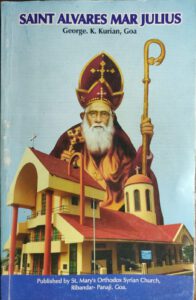
It does not seem like there is anyone today who has known him personally, for he died over a century ago. Those who did remember him, in the years gone by, usually spoke in hushed voices, given his anti-establishment posture; but even his severest critic would admit that he had a heartbeat for the voiceless in Goan society.
Born António Francisco Xavier Álvares (Verna, 29/4/1836), he studied at Rachol Seminary and was ordained a priest in Bombay (the episcopal chair in Goa was vacant). On his return, he set up a charitable society to rehabilitate beggars (some of whom lodged with him in his rented apartment in Panjim) and a church-aided school. Quick to reach out, especially when deadly epidemics raged in the capital, he once personally saved labourers trapped in a landslide triggered by hill cutting.
The focus of George K. Kurian’s book (Figure 1), however, is the unprecedented entry of that Roman Catholic priest into the Malankara Orthodox Syrian Church. Until his early public years, Fr Álvares was a conservative and loyalist to the point of defending Portugal’s Padroado rights; what, then, was really the tipping point?
Kurian points a finger at Archbishop António Sebastião Valente’s objections to the tenor of Fr Álvares’s writings in the local press (pp 53, 81); but alas, he stops short of identifying the genesis of his unease, which predated Valente’s arrival in 1882. Over a period of 18 years (1877-1895), the cash-strapped Fr Álvares came to be associated with a number of periodicals (A Cruz; A Verdade; O Progresso de Goa; The Times of Goa and Brado Indiano), in different capacities. Whether or not his politically minded associates and/or funders rode piggyback is a moot point.
Similarly, the author states that the Catholic Church in Goa excommunicated Fr Álvares (pp 75, 158), but provides no proof in support of the claim. It was more likely an excommunication that the priest incurred automatically (latae sententiae), as per the Code of Canon Law, as a result of his entry into the Malankara church in 1887.
At any rate, the purpose of an excommunication is to call a person to change behaviour, repent, and return to full communion. But none of that happened. Instead, in 1888, Fr Álvares went on to form the Independent Catholic Mission of Brahmavar, Karnataka. Was this in response to the Padroado-Propaganda Fide imbroglio?
The rest is history. In 1889, Mar Dionysius, who headed the Malankara church, appointed Fr Álvares to a specially created episcopal post of Metropolitan of Goa, India (excluding Malabar) and Ceylon. Titled ‘Mar Julius’, he still said Mass in Latin (his Syriac and Malayalam were not up to par), catering to the Indian Orthodox Church’s Roman Catholic lay entrants, who were permitted ‘a separate rite and liturgy’ (p. 62). He highlighted the antiquity and authenticity of Antioch vis-à-vis Rome (p. 91) and criticised Western cultural practices in vogue in Goa as against the preferential status that Indian traditions were given in Malabar (p. 54).
In the period 1887-1911, Fr Álvares divided his time between Ceylon, Kerala, Brahmavar and Goa (pp 63, 71). In 1890, the Goa police booked him for unauthorised use of ecclesiastical vestments (p. 111), but the court, on taking cognisance of his episcopal status, acquitted him. On a later visit to his native land, he championed the use of indigenous products (‘a forerunner of the great Swadeshi Movement’, p. 95) and found himself in a spot for denouncing the powers-that-be. He was ultimately charged with sedition and arrested for inciting the Maratha sepoys and Ranes through his writings (p. 113). The court exonerated him (which speaks volumes about the justice delivery system), but Fr Álvares fled yet again, fearing reprisals.
In 1911, Fr Álvares was at the receiving end of a feud between the Patriarch of Antioch and Mar Dionysius (p. 87). It was as if life had come full circle when, excommunicated for siding with the latter, he relocated to Goa and stayed in the same old, ground-floor apartment off Ourém Street. The big difference now was that the Republicans were in power in Portuguese India; but was that why the Malankara archbishop left his domain in Karnataka?
It would be interesting to know what Fr Álvares thought of that secular (read anticlerical) regime, other than that he was left in peace. This time around, he set up an English-medium school and made a plea for primary education in Konkani (p. 78). While in the past he had very relevantly published booklets on the treatment of cholera, presently he advocated large-scale cultivation of manioc as a solution to Goa’s food crisis. Finally, in the evening of his life, devoting himself entirely to charity work, he actually went out with a begging bowl.
Not surprisingly, the longest of the book’s 18 chapters is titled ‘A True Missionary’, which speaks about Fr Álvares’ apostolic work, his associates and the expansion of the Malankara church in India and abroad. The last few chapters describe the final days of this ‘martyr and saint’; his funeral; long-standing friendships; tomb at St. Inez Cemetery; and the formation and work of the Orthodox Church in Goa. Kurian notes that the Roman Catholic Church’s efforts to win Fr Álvares back were in vain. The dying priest insisted that if not the Orthodox Church, his friends alone would bury him (p. 118). He died at Ribandar public hospital (23/9/1923).
The topic of retired bureaucrat George K. Kurian’s self-published volume is intriguing no doubt, but more rigorous editing would certainly enhance clarity and coherence. It is a pity that instances of repetition, typos and grammatical errors detract from the overall reading experience. The book was originally written in Malayalam and is a work of love. The author even took the trouble to include a family tree of the Álvares, besides photographs of the priest and pages of Diário da Noite and O Heraldo, two dailies that covered the funeral and aftermath. All in all, the book helps get a glimpse of the enigmatic figure of Padre Álvares/Mar Julius.
Beauty of being Church
The Readings of the Third Sunday of the Year provide important insights into two momentous beginnings: one, the great religious reform introduced by Nehemiah, with the help of Ezra and the Levites, in the First Reading (Neh. 8: 2-6, 8-10); and the other is Jesus’ teaching ministry, which gave birth to Christianity, in the Gospel (Lk 1: 1-4; 4: 14-21).
Nehemiah was a Jewish leader, and later governor, who supervised the rebuilding of Jerusalem (mid-5th century BCE) after the release of the Jews from their exile in Babylon. The Book of Nehemiah, partly based upon his memoirs, was later put together by an anonymous writer, who apparently also compiled the books of Ezra and the Chronicles.
Nehemiah introduced moral and liturgical reforms in rededicating the Jews to Yahweh. In today’s passage, we see the zealous public imparting of the knowledge of God to people of goodwill. The assembly thus gathered served as a model for the religious life of the Jewish community.
About the Sabbath, governor Nehemiah, the priest and scribe Ezra, and the Levites[1], taught the people: ‘This day is holy to the Lord your God; do not mourn or weep.’ The people wept tears of repentance for their earlier misdeeds. While they were then encouraged to rejoice in the Lord and be happy, it was not solely about partying (‘eat the fat and drink sweet wine’) but about partaking of the neighbours’ misfortunes as well (‘send portions to him for whom nothing is prepared’).
In a close parallel, Jesus preaches in the synagogue of Nazareth. After His Baptism, He had ‘returned in the power of the Spirit into Galilee, and a report concerning Him went out through all the surrounding country.’ When He was given the Book of Isaiah to read aloud from, behold the passage He found when He opened the Book:
‘The Spirit of the Lord is upon me, because He has anointed me to preach good news to the poor. He has sent Me to proclaim release to the captives and recovering of sight to the blind, to set at liberty those who are oppressed, to proclaim the acceptable year of the Lord.’
If this Old Testament passage, like many others, is not an allusion to Jesus, what is? When Jesus closed that book, the eyes of all in the synagogue were fixed on Him. And Jesus went ahead and proclaimed, ‘Today this scripture has been fulfilled in your hearing.’ All spoke well of Him, and wondered at the gracious words which proceeded out His mouth.
Finally, in continuation of last Sunday’s Pauline passage on the spiritual gifts, the said Apostle speaks of the Church as one body with many members (1 Cor: 12: 12-30). He compares the Church to our physical body, which has many members, and yet all of them make up one body. In fact, the metaphor of the body, to mean the unity of an organised society with diverse members, was commonly used by Greeks and Romans. St Paul says that, likewise, Christians by faith and baptism become members of the Mystical Body of Christ.
The good news is that all have a place in the Church – whether young or old, rich or poor, educated or uneducated; and all of them are respectable – whether apostles, prophets, teachers, miracle workers, speaking in tongues, or whoever. The only condition is that we have to believe in Christ, receive the sacraments He instituted and remain in obedience to the authority He established.
Bonding is effected through both suffering and rejoicing. ‘If one member suffers, all suffer together; if one member is honoured, all rejoice together.’ Unity in diversity is the beauty of being Church; but the highest beatitude is that the People of God attain to salvation (CCC 874) Something that has come down to us from Nehemiah and was perfected by our Saviour Jesus Christ. We are called to be people of God and heralds of His glad tidings.
This year we are in the Jubilee Year (which Nehemiah had reinstated).[2] In the Catholic Church it is a Year of forgiveness, reconciliation, and renewal of faith. Let us move forward as 'Pilgrims of Hope'.
[1] Member of a group of clans of religious functionaries, their lineage is traced back to Levi, the third son of Jacob and Leah.
[2] The 2025 Jubilee Year began on 24 December 2024 and will end on 6 January 2026. The theme for 2025 is ‘Pilgrims of Hope’.
SFX: Vídeo e Coro | Video and Choir

HINO TRADUZIDO A SÃO FRANCISCO XAVIER: VÍDEO E CORO
O icónico hino “Sam Fransiscu Xaviera”, em concanim de Goa, musicado há mais de um século por Raimundo Barreto (1837-1906), foi recentemente traduzido para português pelo nosso editor associado Óscar de Noronha (vide Revista da Casa de Goa, II, n.º 31, Set-Out 2024, pp 56-58). Esta é a primeira tradução da letra original do hino, que tem 11 estrofes. https://epaper.heraldgoa.in/article/oHeraldo?OrgId=112e47795a7&eid=0&imageview=0&standalone=1&device=desktop
Em 30 de novembro, o tradutor lançou uma gravação em estúdio da primeira e última estrofe do hino, no seu canal de YouTube https://youtu.be/GRYIB-Yp3lk?si=cy-8CPW4JqM8rU7R
A versão traduzida foi cantada publicamente, pela primeira vez, na missa em português que se realiza todos os anos no dia 1 de dezembro, por ocasião da novena de São Francisco Xavier em Velha Goa https://youtu.be/11Th2Kz_E8o , missa celebrada este ano por D. Tonito Francisco Xavier Muananoua, bispo auxiliar da arquidiocese de Maputo. O hino foi cantado pelo coro da Igreja de Nossa Senhora da Imaculada Conceição, de Pangim, a única igreja em Goa onde todos os domingos se celebra uma missa em português. https://www.gomantaktimes.com/news/goa/over-5000-attend-portuguese-mass-at-sfx-exposition-in-goa
Reconhecendo esse cântico como “o hino da comunidade católica goesa no país e no estrangeiro”, o jornal The Times of India afirmou que o novo vídeo tem recebido assinaláveis elogios nas redes sociais. Espera-se que também seja bem recebido pela diáspora goesa de língua portuguesa. https://timesofindia.indiatimes.com/city/goa/goencho-saibs-most-popular-hymn-gets-a-portuguese-tribute-at-old-goa/articleshow/115907224.cms
-o-o-o-

TRANSLATED HYMN TO ST FRANCIS XAVIER: VIDEO AND CHOIR
Goa’s iconic Konkani hymn “Sam Fransiscu Xaviera”, set to music over a century ago, by Raimundo Barreto (1837-1906), was recently translated into Portuguese by our associate editor Óscar de Noronha (see Revista da Casa de Goa, No. 31, Sep-Oct 2024, pp 56-58). This is the first-ever translation of the original lyrics of the hymn running into 11 stanzas. https://epaper.heraldgoa.in/article/oHeraldo?OrgId=112e47795a7&eid=0&imageview=0&standalone=1&device=desktop
On 30 November, the translator released a studio recording of the hymn’s first and last stanzas on his YouTube channel https://youtu.be/GRYIB-Yp3lk?si=cy-8CPW4JqM8rU7R
The translated version was sung publicly for the first time at the Mass in Portuguese that is held on 1 December every year on the occasion of the novena to St Francis Xavier at Old Goa https://youtu.be/11Th2Kz_E8o , which Mass this year was celebrated by D. Tonito Francisco Xavier Muananoua, auxiliary bishop of the archdiocese of Maputo. The hymn was sung by the choir of Our Lady of the Immaculate Conception Church, Panjim, the only church in Goa where a Mass in Portuguese is held every Sunday. https://www.gomantaktimes.com/news/goa/over-5000-attend-portuguese-mass-at-sfx-exposition-in-goa
Hailing the hymn, as ‘the anthem of the Goan Catholic community at home and abroad’, The Times of India stated that the new video has been garnering rich praise on social media. It will hopefully be welcomed by the Portuguese-speaking Goan Diaspora. https://timesofindia.indiatimes.com/city/goa/goencho-saibs-most-popular-hymn-gets-a-portuguese-tribute-at-old-goa/articleshow/115907224.cms
Salvos and Salvation
Even a glimmer of hope that the Gaza ceasefire will go into effect today seems to have instantly put the world at ease. But will the behind-the-scenes arm-twisting by the US President-elect really spell the end of the salvos? And whether or not the parties concerned will honour the deal, or how long they will do so, is just anybody’s guess.
Israel has always been a hard nut to crack. Ironically, the nation that comprised God’s Chosen People has long since been at loggerheads with Him. It is said that in the past God spoke to them through the prophets, but to no avail. Finally, two millennia ago He spoke to them by his Son, again in vain. The saving grace is that after this time the divine message was proclaimed to the world at large.
The First Reading (Is 62: 1-5) on this Second Sunday in Ordinary Time is witness to how God’s People, long exiled and suffering in Babylon, were not forsaken by Him. In fact, the Prophet Isaiah joyfully announces their impending salvation. God will not rest until ‘her vindication shines out like the dawn, her salvation like a blazing torch.’
The most shining image through it all is that of marriage. ‘As a young man marries a young woman, so will your builder marry you; as a bridegroom rejoices over his bride, so will your God rejoice over you.’ And to better define the love by which God wishes to restore His ties with his People, Isaiah picks up this key Scriptural theme of the marriage of God and Jerusalem.
Is it any wonder, then, that the first miracle that Jesus performed was at a marriage in Cana? While the Gospel (Jn 2: 1-11) describing this ‘sign’ (miracle) harks back to Isaiah, it also establishes Jesus as the Son of God and helps take forward His salvific plan. And Mary’s discreet participation is not to be missed. She not only suggested to her Son that His intervention was the need of the hour; she went ahead and created the right conditions by instructing the servants to do whatever He told them.
Here were two persons who cared and went out of their way to prove they cared. In human terms, this reaching out by Mother and Son was a sure way to win the people’s confidence and trust. But this was only the beginning, not an end in itself. The larger concern was the spiritual salvation of those people. The changing of the water into wine should have led the people to lose themselves in the Wonder Worker. But here again, Israel proved to be a hard nut to crack.
What about you and me? Do we firmly believe that Jesus is our personal and universal Saviour? That His Mother is Mediatrix and Co-Redemptrix? By becoming the ‘handmaid of the Lord’, she made possible the birth of the Son of God. And today we see her as catalyst in Her Son’s public life. At first, He seems to reject her suggestion but soon we see Him doing precisely what she had suggested. This not only goes to show how much Jesus valued His Mother but also how we must hold her in high esteem.
Finally, while Christ is the Bridegroom, none other than the Church is the Bride of Christ. And behold how the believers that comprise the Church are wedded together. The Second Reading (1 Cor: 12: 4-11) states that there is a diversity of ministries and operations but the same Lord and God.
Similarly, the Holy Spirit manifests Himself in us the believers through charisms: He gives to one the word of wisdom, to another, the word of knowledge, and similarly, faith, grace of healing, the working of miracles, prophecy, the discernment of spirits, the gift of tongues, interpretation of speeches, and so on, but all as per of that same Spirit.[1] Yet, these gifts are not meant for self-aggrandisement but to bring about our ultimate salvation.
A close-knit family of believers ought to be the apple of our eye. Family cohesion comes as fruit of a blessed marriage. God and His people together none can put asunder. And no matter how soon we see the end of the salvos, real salvation comes from God alone. He is our Spes Unica, our only hope!
[1] Operations, services and charisms refer to the same experience but are named differently as to be attributed to the Three Persons of the Holy Trinity.

